Svo2 - Study guides, Class notes & Summaries
Looking for the best study guides, study notes and summaries about Svo2? On this page you'll find 656 study documents about Svo2.
Page 4 out of 656 results
Sort by
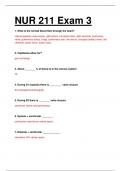
-
NUR 211 EXAM 3. QUESTIONS AND ANSWERS
- Exam (elaborations) • 14 pages • 2023
-
- $8.99
- + learn more
What is the nurses role in inserting a PA catheter? What is the correct position for PA catheter insertion? during insertion of a PA catheter, which part of the heart is most dangerous to pass through? What are some complications of PA monitoring? After insertion of a PA monitoring device, get a chest __________ to verify placement Once the PA catheter is in place: Obtain PAP/PAWP measurements at end __________ PAWP estimates ____________ of the left heart I...
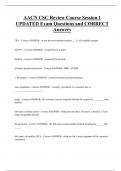
-
AACN CSC Review Course Session 1 UPDATED Exam Questions and CORRECT Answers
- Exam (elaborations) • 7 pages • 2024
-
- $7.99
- + learn more
AACN CSC Review Course Session 1 UPDATED Exam Questions and CORRECT Answers 70% - Correct ANSWER- at rest the myocardium extracts ___% of available oxygen 30-35% - Correct ANSWER- normal SvO2 in heart 60-80% - Correct ANSWER- normal SvO2 in body coronary perfusion pressure - Correct ANSWER- DBP - LVEDP > 40 mmHg - Correct ANSWER- normal coronary perfusion pressure
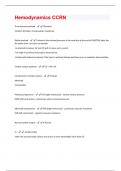
-
Hemodynamics CCRN Questions and Answers well Explained Latest 2024/2025 Update 100% Correct.
- Exam (elaborations) • 8 pages • 2024
- Available in package deal
-
- $7.99
- + learn more
Tx to decrease preload - -Diuretics -Dilators (nitrates, nitroprusside, morphine) Define preload - -Preload is the volume/pressure in the ventricle at the end of DIASTOLE after the AV valves close, just prior to ejection -As preload increases, SV and CO will increase up to a point -Too high of a preload may lead to heart failure -Preload will seldom be elevate if the heart is without disease and there are no metabolic abnormalities Cardiac output equation - CO = HR x SV Components of str...
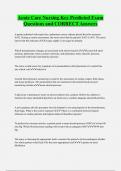
-
Acute Care Nursing Key Predicted Exam Questions and CORRECT Answers
- Exam (elaborations) • 13 pages • 2024
-
- $7.99
- + learn more
A patient admitted with sepsis has a pulmonary artery catheter placed that also measures SvO2. During a routine assessment, the nurse notes that the patient's SvO2 is 56%. The nurse knows that this indicates:oxygen supply is not equal to demand. Which hemodynamic changes are associated with mitral stenosis?Elevated left atrial pressure, pulmonary artery occlusive pressure, and pulmonary artery diastolic pressure; normal left ventricular end-diastolic pressure
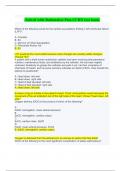
-
(Solved with Rationales) Pass CCRN test bank.
- Exam (elaborations) • 47 pages • 2023
-
- $10.99
- + learn more
(Solved with Rationales) Pass CCRN test bank. Which of the following would be the earliest auscultatory finding in left ventricular failure (LVF)? A. Crackles B. S3 C. Murmur of mitral regurgitation D. Pericardial friction rub B. S3 LVF would be the most subtle because early changes are usually subtle changes. Choose "S3." A patient with a triple-lumen subclavian catheter has been receiving total parenteral nutrition, maintenance fluids, and antibiotics by the catheter. He has ...
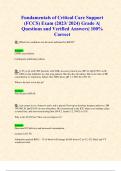
-
Fundamentals of Critical Care Support (FCCS) Exam (2023/ 2024) Grade A| Questions and Verified Answers| 100% Correct
- Exam (elaborations) • 30 pages • 2023
- Available in package deal
-
- $10.99
- + learn more
Fundamentals of Critical Care Support (FCCS) Exam (2023/ 2024) Grade A| Questions and Verified Answers| 100% Correct Q: Which two conditions are the most indicated for BiPAP? Answer: COPD exacerbation Cardiogenic pulmonary edema Q: A 70 y/o pt with CHF presents with SOB, accessory muscle use, RR 34, SpO2 90% on 8L O2. CXR reveals infiltrates in a bat wing pattern. She also has LE edema. She is dx with a CHF exacerbation w/ respiratory failure. Her ABG shows pH 7.3, PO2 64, CO2...

-
CCRN questions Hemodynamics Updated 2024/2025 Verified 100%
- Exam (elaborations) • 11 pages • 2024
- Available in package deal
-
- $7.99
- + learn more
One hemodynamic benefit of intra-aortic balloon therapy is: A) Balloon inflation prevents right to left shunt B) Balloon deflation increases coronary artery perfusion C) Balloon inflation optimizes aortic valve performance D) Balloon deflation decreases left ventricular afterload - D) Balloon deflation decreases left ventricular afterload Which of the following hemodynamic profiles would benefit from aggressive fluid administration, pressors and antibiotic therapy? A) RAP 1, PAOP 4, SVR ...
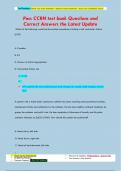
-
Pass CCRN test bank Questions and Correct Answers the Latest Update
- Exam (elaborations) • 102 pages • 2024
-
- $14.49
- + learn more
Which of the following would be the earliest auscultatory finding in left ventricular failure (LVF)? A. Crackles B. S3 C. Murmur of mitral regurgitation D. Pericardial friction rub B. S3 LVF would be the most subtle because early changes are usually subtle changes. Choose "S3." A patient with a triple-lumen subclavian catheter has been receiving total parenteral nutrition, maintenance fluids, and antibiotics by the catheter. He has been slightly confused. Suddenly he gra...
![CCRN PASS TEST BANK EXAM WITH QUESTIONS AND WELL VERIFIED ANSWERS [ALREADY GRADED A+] ACTUAL EXAM 100% REAL EXAM!!](/docpics/5843763/66994fb7376d7_5843763_121_171.jpeg)
-
CCRN PASS TEST BANK EXAM WITH QUESTIONS AND WELL VERIFIED ANSWERS [ALREADY GRADED A+] ACTUAL EXAM 100% REAL EXAM!!
- Exam (elaborations) • 90 pages • 2024
-
- $20.49
- + learn more
CCRN PASS TEST BANK EXAM WITH QUESTIONS AND WELL VERIFIED ANSWERS [ALREADY GRADED A+] ACTUAL EXAM 100% REAL EXAM!!! A patient with a triple-lumen subclavian catheter has been receiving total parenteral nutrition, maintenance fluids, and antibiotics by the catheter. He has been slightly confused. Suddenly he grasps the catheter and pulls it out. He then complains of shortness of breath, and his pulse oximetry indicates an SpO2 of 84%. How should this patient be positioned? A. Head...
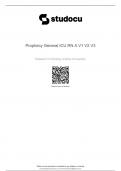
-
Prophecy General ICU RN A V1, V2 &V3
- Exam (elaborations) • 16 pages • 2024
- Available in package deal
-
- $8.49
- + learn more
Prophecy General ICU RN A V1 What is cardiac tamponade? Fluid in the pericardial sac causing decreasing preload. This decreases SV and ultimately CO. Effects of Hyper/Hypokalemia and calcemia on EKG Hypokalemia causes U waves Hyperkalemia causes peaked T waves Normal BP? 90-120/60-80 Normal HR? 60-100 bpm Normal CO? 4-8 L/min Normal SVR? 800-1,200 dynes/seconds Normal PVR? 37-250 dynes/sec/cm5 Normal SVo2? 60-80% Normal PAP? Systolic: 15-30 mm Hg Diastolic: 4-12 mm Hg Normal...

Did you know that on average a seller on Stuvia earns $82 per month selling study resources? Hmm, hint, hint. Discover all about earning on Stuvia


